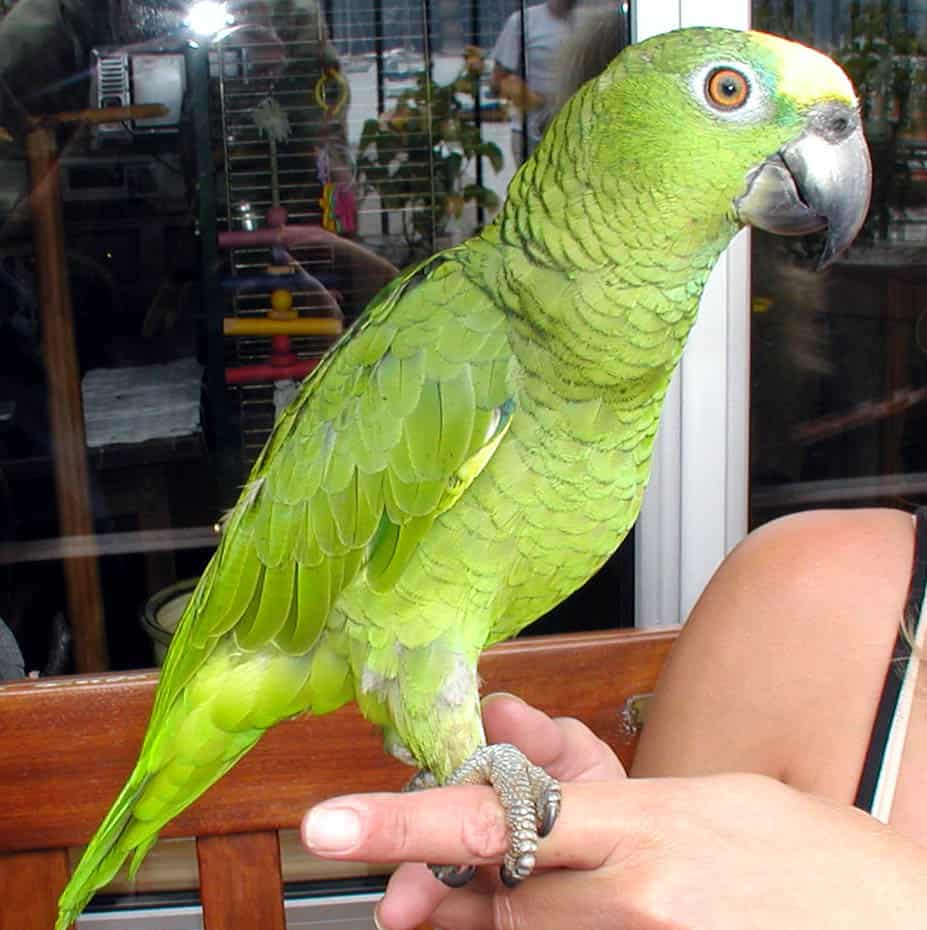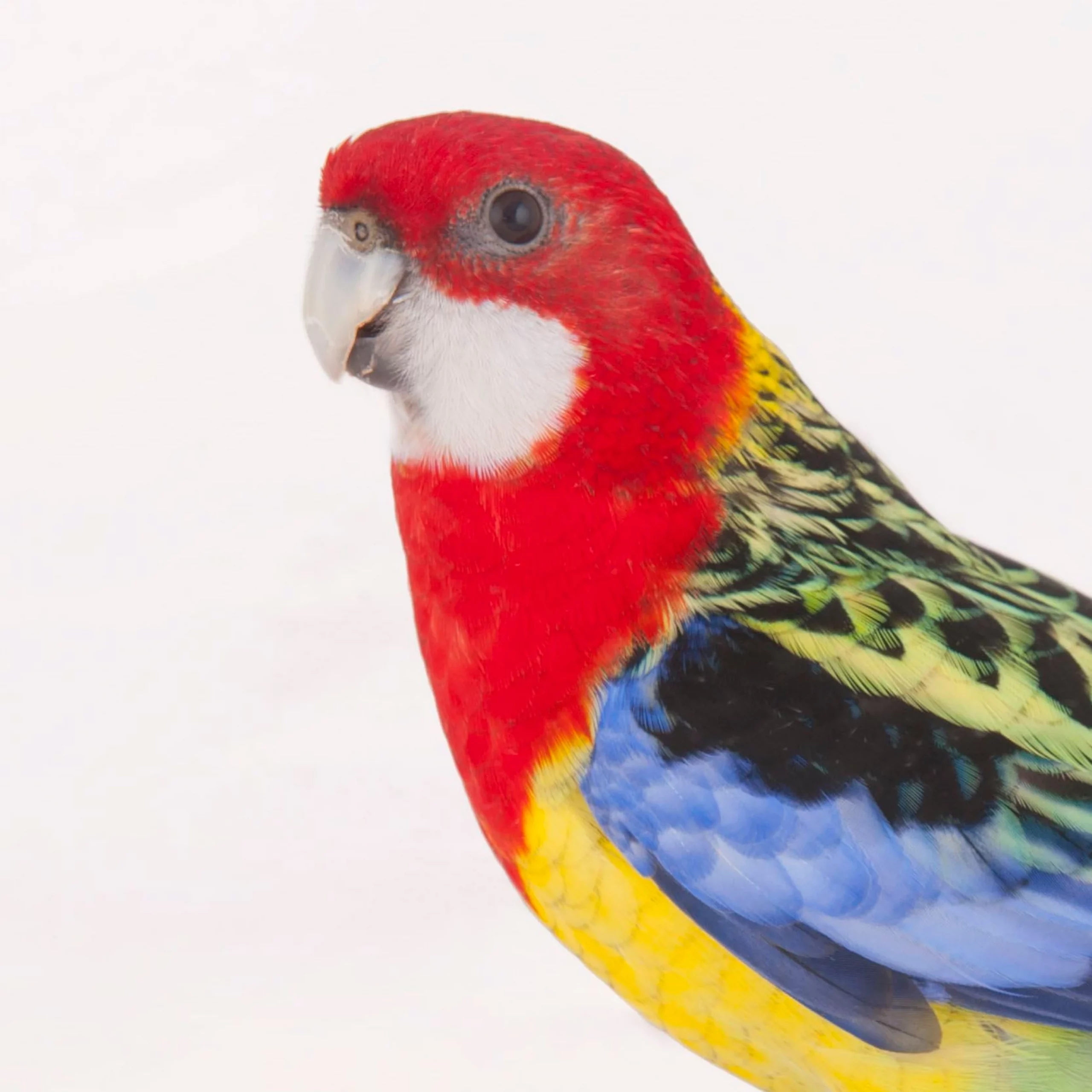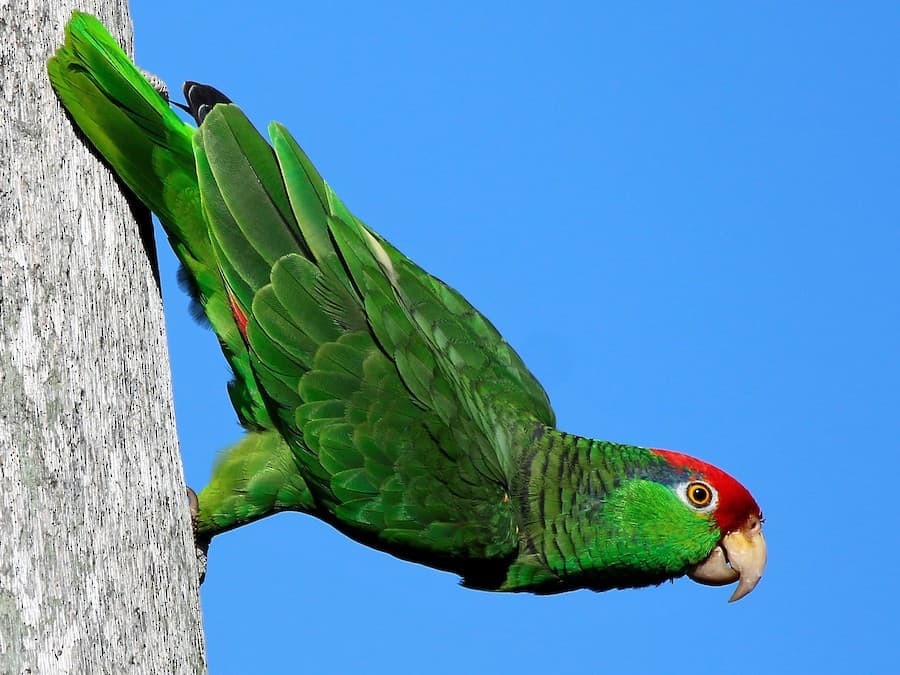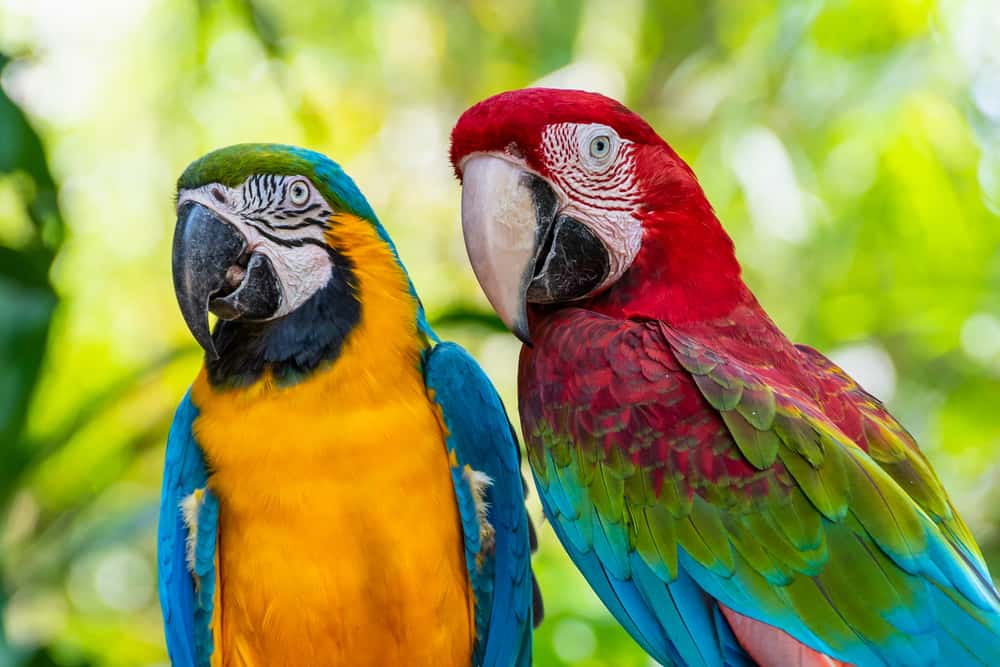You probably already know what a parrot is; most people do. However, do you know its features, reproduction process, and what it feeds on in the wild and in captivity? Do you know the nutrients they need to grow healthy and the toxic foods that could harm them?
Whether you are considering getting a parrot as a pet or want to learn everything you can about them, you are here because you are wondering: What do parrots eat? This article covers everything you need to know about these beautiful birds.
Facts about Parrots
Parrots are beautiful birds with different colors such as orange, black, yellow, green, white, and brown, and some are multi-colored. These birds also vary in size depending on the species. There are around 372 species of parrots.
The feathers of parrots get their bright, vivid colors from an antibacterial pigment that no other species is known to produce. The antibacterial pigment, Psittacofulvins, prevents damage to their beautiful feathers.
Tropical climates are where most parrots subside, although some make their habitat in the southern hemisphere song with many regions worldwide. Some species even prefer the cold, so they flock to more excellent areas.
Some characteristics are curved beaks and zygodactyl feet – parrots have four toes, with two facing the front and the other two pointing backward.
Parrots are very social birds, so they usually travel in flocks and are hardly ever alone in the wild. The birds do almost everything in groups, from eating to bathing.
Parrots are also well known for their ability to mimic different sounds, including human speech. Since parrots are social, pet parrots become highly attached to their humans and require a lot of attention to maintain their emotional well-being.
Smithsonian mentions parrots’ that do not get adequate socialization are likely to become stressed and may even resort to plucking out their feathers. It is vital to consider if you have enough time for a parrot if you are deciding whether or not to get a feathery companion.
Most parrot species are monogamous, meaning they only have one partner in their lives. However, mating doesn’t occur between parrots with different species.
Petkeen says the process of parrots finding a mate is competitive. Like other animals, male parrots compete for the affection of a female parrot. A male parrot abundant in brightly colored feathers is more likely to attract a mate since it signals health and strength.
According to All About Parrots, after two parrots have paired up, they will build a cavity nest to lay their eggs. The parrots copulate, eggs are then formed and fertilized in the female parrot, and it begins to lay eggs for incubation. The incubation period lasts for about 2½ to 4 weeks.
Essential Nutrients That a Parrot Needs

Some species of parrots can live to around 60 to 90 years! However, they need nutrients that will support them so they can thrive. Here are some significant nutrients and minerals that parrots need to flourish.
Like all living things, parrots need water to survive. However, treated tap water with fluoride can be harmful to parrots. If you are providing a parrot with water, purified water is best.
Calcium is also essential in forming parrots’ bones, feathers, and beaks. It makes the beak stronger for it to break any hard food substances. In addition, calcium helps in eggshell formation, secretion of hormones, and the development of a parrot’s muscles.
While calcium is essential to the well-being of parrots, too little or too much of it can result in the loss of their feathers. Furthermore, a calcium imbalance can damage the parrot’s internal organs.
Lastly, magnesium is a kind of vital nutrient parrots need to survive. Without magnesium, a parrot’s body cannot use calcium and other vitamins. Magnesium also promotes heart health, relaxes muscles, and aids muscle coordination.
What Do Parrots Eat?

A parrot’s diet consists of plants and animals because they are omnivores; however, they usually snack on fruits, nuts, seeds, flowers, and insects. Wild parrots will not likely rely on animals as a food source.
Seeds are a parrot’s favorite food because they can crack the shells with their hard beaks. However, they do not provide enough of the nutrients a parrot needs for them to be their only source of sustenance.
Parrots also love nuts! Some of their favorite nuts are pistachios, cashews, peanuts, walnuts, hazelnuts, Brazil nuts, almonds, and pecans. Nuts have a high nutritional value and are generally rich in protein, potassium, fiber, phosphorus, magnesium, vitamin C, and vitamin E.
Vegetables are also a good source of these nutrients. While parrots only have around 300 taste buds found on the roof of their mouths, they still have a fondness for particular foods.
What Do Parrots Eat in The Wild?
Wild parrots can be seen in different countries where there are warmer temperatures. They are hard to miss because of their beautiful, brightly colored feathers.
The foods that parrots feed on in the wild vary by species and the habitat in which they live. Wild parrots eat a wider variety of food than pet parrots or parrots that live in a zoo since wild parrots forage for their food.
Wild parrots love to eat wild berries! Unfortunately, some berries are poisonous just like they are to humans, and parrots end up eating them by mistake.
Contrary to parrots born in captivity, wild parrots also eat numerous species of flowers. This is not their first choice, but parrots will eat them when other food sources are scarce.
Another food source wild parrots eat an abundance of is insects such as fly larvae and caterpillars, along with crickets and mosquitos.
Although it isn’t common, some wild parrot species will eat bird eggs, and some will even feed on the flesh of deceased animals to survive.
Like active individuals require more calories a day than sedentary individuals, wild parrots can consume four times their weight in just a day because of how much energy they lose when they fly.
What Do Parrots Eat in Captivity?
Pet parrots are lovely additions to the homes they find themselves in because they are bright and intelligent. Parrots in captivity have a slightly different diet because their food is given to them rather than foraging.
Parrots in captivity rely on pellets as their sole source of nutrition. Pellets are made from various food sources containing the nutrients parrots need. These pellets contain whole grains like rice, barley, and quinoa and seeds such as sunflower seeds and sesame seeds.
Aside from pellets, the rest of your parrot’s diet should consist of whole foods. Vegetables like kale, broccoli, green beans, bell peppers, and carrots are a great addition to a parrots diet, along with black beans, tofu, and chickpeas.
You can also feed parrots fruits such as apples, guava, oranges, banana, watermelon, kiwis, berries, dragon fruit, grapes, mangoes, and pineapple.
You may want to try out dried fruits but bear in mind that the sugar concentration would have increased because it’s dried, so feed your pet more fresh fruits.
Nuts are perfectly ok for your parrot, too. However, use caution in feeding them too many nuts, seeds, and fruit because captive parrots are not as active as wild parrots are.
Wild parrots spend most of their days flying and foraging for food, but captive parents do not get as much exercise. This means they won’t burn off the excess fats and sugars as quickly, which could lead to severe health issues.
What Do Baby Parrots Eat?
Having discussed what adult parrots feed on and should not feed on, let us briefly discuss what their babies eat. Baby parrots or hatchlings are born with closed eyes and rely solely on their parents for food.
According to AZ Animals, the parents feed their hatchlings regurgitated food from their last meal.
However, when a hatchling is not with its mother, its owner must feed it for about 4-5 months until it can eat on its own. Until your chick is old enough to eat pellets and nuts, you can feed it with soft and fresh fruits, vegetables, and soft seeds.
In addition, you should use warm water when making baby parrots’ foods.
What Foods Can Parrots Not Eat?
Parrots love to eat what they eat, but some foods are extremely harmful. Eggplant is one food parrots shouldn’t eat as it contains solanine. Solanine is a poison that causes parrots to have neurological and gastrointestinal disorders.
Onions and garlic are also foods to avoid feeding your parrot as they contain sulfoxide, which irritates your bird’s stomach and esophagus, potentially causing ulcers and anemia.
Surprisingly, avocado is off limits as well! Avocado contains persin, a form of acid that causes respiratory problems and breathing issues in birds.
While dairy isn’t toxic, you should avoid giving it to your parrot. Dairy foods contain lactose which is hard for parrots to digest because they are lactose intolerant.
Another essential thing to mention is that when you feed your parrot fruit, cut the fruit first to avoid giving your bird the pits and seeds. Pits and seeds from certain fruits like apples contain amygdalin, a toxic cyanide-sugar compound that can cause cyanide poisoning.
Other foods to avoid giving your parrot are chocolate, caffeine, fatty foods, and artificial sweeteners.
How To Care For Your Parrots?

If you are considering investing in a parrot or already have one, here are some tips for caring for your parrot to ensure they have a long and happy life.
Knowing that your pet will spend most of its years in its cage, ensure you get a large cage with enough space to spread its wings as it grows and matures. Enough space will also encourage it to exercise itself.
You should place the cage where the parrot can enjoy sufficient air. Do not place the cage where there is direct sunlight. Also, ensure you do not place the cage where smoke or fumes exist.
Check the cage often. A dirty cage may cause bacteria to your parrot, so you must wash it at least every two days and bathe it.
Ensure your parrot is well fed – get foods containing the nutrients and vitamins it needs. You should also keep treats like dried fruit around for your parrot(bearing in mind the foods it must not eat).
Lastly, ensure you give your parrot a lot of love and attention. Since parrots are such social animals, they need to play and connect with others often. These birds love talking with humans and learning since they are one of the most intelligent creatures.
Also, be sure to invest in toys for your parrot to challenge them and provide them with something to do when you are not there and some toys for you to play with together. World Bird has a great list of toys you may want to consider buying for your new family member.
Final Words
Parrots are beautiful and fascinating animals for so many different reasons. It is no wonder you took an interest in them.
I hope you found everything you need to know regarding what parrots eat and other helpful information about parrots and how to care for them as pets. Please comment if you have any questions!
Key Takeaways
- Parrots are omnivorous, so they will eat vegetables and meat.
- Parrots’ favorite foods are nuts, seeds, flowers, and insects, but they also eat plenty of vegetables.
- If you want to get a parrot as a pet, ensure you have the time to care for it properly because parrots are social creatures and need a lot of love and attention.
- Don’t feed parrots avocado, eggplant, onions, garlic, chocolate, caffeine, or artificial sweeteners, and avoid dairy.
- Seeds and pits of certain fruits are toxic, so be sure to cut the fruit off before feeding it to your parrot
